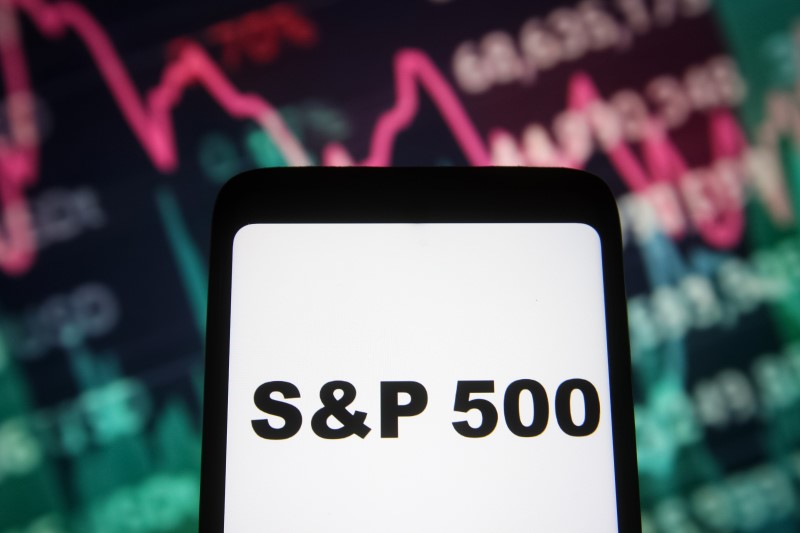© Reuters. Traders work on the floor at the New York Stock Exchange (NYSE) in New York City, U.S., February 6, 2024. REUTERS/Brendan McDermid/File Photo
By David Randall and Saqib Iqbal Ahmed
(Reuters) – As Treasury yields march higher, some investors are betting a resilient U.S. economy and moderating inflation can shield stocks from their deleterious effects this time around.
Rising yields are often viewed as a hindrance to stocks since they increase the allure of bonds compared to equities while raising the cost of capital. The plunged 19.4% in 2022 when yields soared as the Federal Reserve raised interest rates to head off a surge in inflation and wobbled again when yields spiked to 16-year highs last year – though stocks came screaming back once the move reversed.
That relationship was evident again on Tuesday after hotter-than-expected consumer price data for January undercut the case for imminent Fed rate cuts and sent Treasury yields soaring. The benchmark 10-year yield, which moves inversely to bond prices, rose to a 10-week high of 4.297%. The S&P 500 closed down 1.36%, although it stands near record highs hit earlier this week.
Some investors, however, believe stocks are now in a better position to withstand another climb in yields. One reason is a U.S. economy that has proven far more resilient than many expected in the face of higher interest rates, softening concerns about whether tighter monetary policy will hurt growth.
And while investors have curtailed their expectations for how much the Fed will cut borrowing costs, most believe that cooler inflation means U.S. central bank policymakers are still likely to lower rates this year. Consumer prices have risen 3.1% on a 12-month basis, moderating from a four-decade peak of 9.1% in June 2022.
“Rates are higher, but that means that the economy is in pretty good shape,” said Michael Purves, head of Tallbacken Capital Advisors. Meanwhile, inflation is “broadly a lot less scary than it was before.”
Purves expects the to drift up to a range between 4.25% and 4.75%, while equities continue to rally, though at a slower pace. The yield hit a high of just over 5% last year.
“If it’s a non-violent rate move higher, the market and the economy can accommodate it,” he said.
Futures tied to the Fed’s main policy rate show investors pricing in around 90 basis points in cuts this year. That’s down from 150 basis points that markets had priced in last month, though still above the 75 basis points in cuts projected by Fed policymakers at their Dec. 12-13 meeting.
‘POSITIVE EARNINGS’
Investors’ buoyant mood was reflected in BofA’s latest fund manager survey, which showed allocations to global stocks at a two-year high. Optimism about the economy was at its highest level since early 2022.
Many investors have also taken heart from an earnings season that so far has been stronger than expected. With results in from about two-thirds of companies, fourth-quarter earnings growth for the S&P 500 is now seen at 9.2%, almost double a Jan. 1 forecast for 4.7% growth, according to LSEG data on Friday.
“Earnings season was quite good,” said Wei Li, global chief investment strategist at BlackRock (NYSE:). “Across the whole equity market there were more sectors delivering positive earnings, and that was trumping rate repricing.”
A slow move higher in yields over the last couple of weeks has also allowed the market to better digest them, she added.
“Speed sometimes matters more than levels,” she said.
Investors could make an argument for selling if yields keep pushing higher. The S&P 500 is up 20% from its October lows in an advance led mainly by the so-called “Magnificent Seven,” the massive growth and technology stocks that have a heavy weighting in the index.
Persistently strong economic data could also stoke fears of an inflationary rebound that would force the Fed to keep rates higher for longer than investors were expecting.
That could be “very negative for stocks that are interest rates sensitive, particularly small stocks that are facing a requirement to refinance their debt,” said Michael Green, chief investment strategist at Simplify Asset Management.
Bank stocks have been hit hard on expectations that rates will stay higher for longer, with the KBW Regional Banking index down nearly 12.5% on worries over the sector’s exposure to stressed U.S. commercial real estate. The index was off 4.49% on Tuesday.
Lara Castleton, US head of portfolio construction and strategy at Janus Henderson Investors, has grown more cautious on the rally as stocks have advanced in recent weeks.
Yet she believes equities will be supported by still-heavy cash allocations that could give investors ammunition to buy stock dips. Total money market fund assets stood at $6.02 trillion on Feb. 7, according to data from the Investment Company Institute.
“There is too much cash on the sidelines waiting for a buying opportunity to come again,” she said.
Read the full article here
